
(a)
Interpretation: For the given molecular formulae the structure should be predicted.
Concept Introduction:
1H NMR: A technique gives information to predict the Carbon and Hydrogen connectivity in the organic compounds.
HDI (Index of hydrogen deficiency): HDI values gives information on the level of unsaturation (means a double bond or a ring) on the structure of the compound.
(a)
Answer to Problem 32PP
Answer
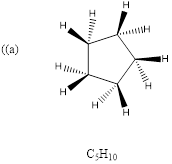
Explanation of Solution
To predict: the structure for the given molecular formula.
Calculate HDI Value for the given molecular formula and draw the structure.
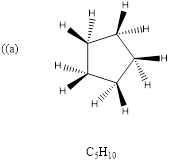
HDI = 1, compound has either 1 ring or one
Therefore, the compound predicted is the cyclopentane.
(b)
Interpretation: For the given molecular formulae the structure should be predicted.
Concept Introduction:
1H NMR: A technique gives information to predict the Carbon and Hydrogen connectivity in the organic compounds.
HDI (Index of hydrogen deficiency): HDI values gives information on the level of unsaturation (means a double bond or a ring) on the structure of the compound.
(b)
Answer to Problem 32PP
Answer
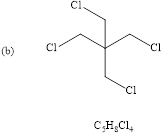
Explanation of Solution
The structure of given molecular formula.(
Calculate HDI value for the given molecular formula and draw the structure:

HDI = 0 , tells the compound is fully saturated (no double bond, triple bond or rings) and the compound is acyclic. Only one proton signal indicates all 4-
Therefore the predicted compound is 1, 3-dichoro-2, 2-dimethylchloropropane.
(c)
Interpretation: For the given molecular formulae the structure should be predicted.
Concept Introduction:
1H NMR: A technique gives information to predict the Carbon and Hydrogen connectivity in the organic compounds.
HDI (Index of hydrogen deficiency): HDI values gives information on the level of unsaturation (means a double bond or a ring) on the structure of the compound.
(c)
Answer to Problem 32PP
Answer
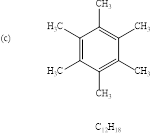
Explanation of Solution
To find: the structure of given molecular formula.
Calculate HDI value for the given molecular formula and draw the structure:
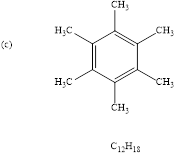
HDI = 4, shows the compound is
Want to see more full solutions like this?
Chapter 15 Solutions
ORGANIC CHEMISTRY (LL) >CUSTOM PACKAGE<
- What would be the reagents and conditions above and below the arrow that will complete the proposed acetoacetic ester synthesis? If it cannot be done efficiently, then I will choose that answer. There could be 2 or 4 reagents involved. Please provide a detailed explanation and drawings showing how it would proceed with the correct reagents.arrow_forwardFor benzene, the ∆H° of vaporization is 30.72 kJ/mol and the ∆S° of vaporization is 86.97 J/mol・K. At 1.00 atm and 228.0 K, what is the ∆G° of vaporization for benzene, in kJ/mol?arrow_forwardThe reaction Q(g) + R(g) → Z(l) is shown to be exothermic. Which of the following is true concerning the reaction. it is spontaneous only at High T, it is spontaneous at low T it is nonspontaneous at all T it is spontanrous at all T. it is non spontaneous only at low T.arrow_forward
- The reaction Q(g) + R(g) → Z(l) is shown to be exothermic. Which of the following is true concerning the reactionarrow_forwardWhich of the following has the largest standard molar entropy, S° (298.15 K) He H2 NaCl KBr Hgarrow_forwardWhich of the following is true for a particular reaction if ∆G° is -40.0 kJ/mol at 290 K and –20.0 kJ/mol at 390 K?arrow_forward
 ChemistryChemistryISBN:9781305957404Author:Steven S. Zumdahl, Susan A. Zumdahl, Donald J. DeCostePublisher:Cengage Learning
ChemistryChemistryISBN:9781305957404Author:Steven S. Zumdahl, Susan A. Zumdahl, Donald J. DeCostePublisher:Cengage Learning ChemistryChemistryISBN:9781259911156Author:Raymond Chang Dr., Jason Overby ProfessorPublisher:McGraw-Hill Education
ChemistryChemistryISBN:9781259911156Author:Raymond Chang Dr., Jason Overby ProfessorPublisher:McGraw-Hill Education Principles of Instrumental AnalysisChemistryISBN:9781305577213Author:Douglas A. Skoog, F. James Holler, Stanley R. CrouchPublisher:Cengage Learning
Principles of Instrumental AnalysisChemistryISBN:9781305577213Author:Douglas A. Skoog, F. James Holler, Stanley R. CrouchPublisher:Cengage Learning Organic ChemistryChemistryISBN:9780078021558Author:Janice Gorzynski Smith Dr.Publisher:McGraw-Hill Education
Organic ChemistryChemistryISBN:9780078021558Author:Janice Gorzynski Smith Dr.Publisher:McGraw-Hill Education Chemistry: Principles and ReactionsChemistryISBN:9781305079373Author:William L. Masterton, Cecile N. HurleyPublisher:Cengage Learning
Chemistry: Principles and ReactionsChemistryISBN:9781305079373Author:William L. Masterton, Cecile N. HurleyPublisher:Cengage Learning Elementary Principles of Chemical Processes, Bind...ChemistryISBN:9781118431221Author:Richard M. Felder, Ronald W. Rousseau, Lisa G. BullardPublisher:WILEY
Elementary Principles of Chemical Processes, Bind...ChemistryISBN:9781118431221Author:Richard M. Felder, Ronald W. Rousseau, Lisa G. BullardPublisher:WILEY





